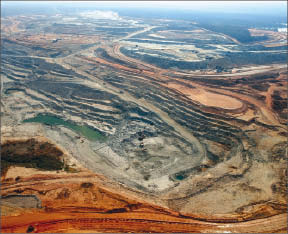Half a year in, Barrick Gold’s (ABX-T, ABX-N) newly purchased Lumwana copper mine in Zambia has done little to rebut the critics who denounced Barrick’s contentious and expensive move into copper through its June 2011 takeover of Equinox Minerals.
Barrick acquired the low-grade, long-life open-pit mine and the smaller-scale Jabal Sayid copper project in Saudi Arabia for $7.3 billion in cash.
Production from three-year-old Lumwana during the June 1 to Dec. 31 period totalled 159 million lbs. copper in concentrate, near the lower end of Barrick’s original guidance of 155 million to 175 million lbs. Operating costs rose significantly, however, to US$2.13 per lb. and US$2.47 per lb. over the year’s third and fourth quarters, respectively, from the original guidance of US$1.75 to US$1.95 per lb.
Cash costs are expected to rise between US$2.40 and US$2.75 per lb. in 2012, with Barrick saying that increased dilution, sequencing to lower-grade benches of the pit, higher labour costs and royalties, higher power costs, mill availability issues and equipment problems are partly to blame.
It expects to produce 230 million to 260 million lbs. copper in concentrate from the mine this year, down from 323 million lbs. produced under Equinox in 2010.
Jabal Sayid in Saudi Arabia is 75% built, with capital costs coming in at US$400 million. The underground mine is expected to produce 35 million to 45 million lbs. copper in 2012 at total cash costs of US$2.15 to US$2.50 per lb., before ramping up to 100 million to 130 million lbs. annually over the next five years at total cash costs of US$1.50 to US$1.75.
For the world’s largest gold producer, the two projects represent a major part of a contentious new plan to marginally diversify away from gold into the industrial red metal. In the years ahead, Barrick will look to derive 80% of its revenue from gold and 20% from copper, instead of its current 90–10 gold and copper revenue mix.
Combined with Barrick’s Zaldivar copper mine in Chile from its 2006 Placer Dome acquisition and its 75%-owned, permitting-stage Cerro Casale gold-copper project, also in Chile, Barrick is hoping to increase annual copper output to 1 billion lbs. by 2017. It produced 451 million lbs. last year and targets 550 million to 600 million lbs. for 2012.
This near-doubling production over the next five years depends heavily on major expansion programs at both Lumwana and Zaldivar, for which prefeasibility studies are expected by year-end and second-quarer 2012, respectively. Barrick has 17 drill rigs at Lumwana completing definition and step-out drilling that could double the mine’s processing rate.
Still, analysts have been quick to question Barrick’s recent move, complaining the company paid top dollar for Lumwana while adding geopolitical risk and losing its pure-play gold status. The company has also used up much of its spare financial capacity to buy copper assets instead of gold assets by issuing US$4 billion of medium- to long-term notes, as well as drawing down on a US$1.5-billion credit facility.
Defending the Equinox bid in the backlash from analysts and investors, Barrick chairman Peter Munk argued it was all about cash flow. “It was the only company we could find that would provide $1 billion to $1.5 billion of cash flow [annually] to fund acquisitions of gold mines,” he said. “I know it’s unorthodox. But if you only do orthodox things, you’re just following the herd.”
Barrick’s average cash costs for copper in 2011 came in at US$1.75, and with an average realized copper price of US$3.82 for the year, the company’s gross profit margin on its copper operations was an impressive 54%.
With gold prices outperforming copper in the year’s second half, however, the gross margin on Barrick’s gold operations was an even-better 70.8%. Barrick produced 7.67 million oz. gold in 2011 at an average US$460 per oz. cash cost, receiving an average US$1,578 per oz. gold over the year.
And when Lumwana’s figures are isolated from the lower-cost Zaldivar copper mine, the gross profit margin of Barrick’s new Zambian mine is further lowered to 40.3%. Zalvidar, in comparison, produced 318 million lbs. copper in 2010 at total cash costs of US$1.09 per lb., realizing an average US$3.41 per oz. copper sold. This resulted in a 68% gross profit margin that year, which is much more in-line with Barrick’s gold operations. The 2011 operational results for Zaldivar are pending. Should Lumwana’s cash costs for 2012 come in at the higher end of guidance, US$2.75, and copper stay around Barrick’s assumed US$3.50 price this year, Lumwana’s margins would erode to 21.5%.
Barrick remains much more highly leveraged to gold prices than copper prices, as the results of an economic sensitivity analysis released alongside Barrick’s fourth-quarter results show.
Assuming a base-case scenario of US$3.50 per lb. copper, every US25¢ or 7% change to copper prices could impact Barrick’s earnings before interest, taxes, depreciation and amortization (EBITDA) by $72 million.
In comparison, every US$50 or 3% change to the gold price, starting with a base case of US$1,700, could impact its EBITDA by US$400 million.
With Lumwana’s lower-than-expected profit margins and hefty price tag, many have come to see Barrick’s Equinox acquisition as a fundamental bet on copper, rather than a strategic gain of a world-class asset.
And until Lumwana’s performance improves, its reserves and resources dramatically expand or the price of copper rises significantly, that view will remain in place.
Trading around US$3.70 per lb. at presstime on Feb. 17, copper prices remain off from a US$4.60 high reached in first-half 2011, but are up slightly from a 52-week, US$3.07 low in October.


Be the first to comment on "Lumwana’s margins below Barrick’s expectations"